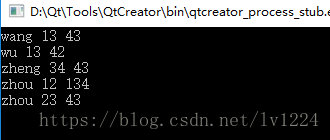C++之set自定义排序问题
作者:沧海漂游_
这篇文章主要介绍了C++之set自定义排序问题,具有很好的参考价值,希望对大家有所帮助,如有错误或未考虑完全的地方,望不吝赐教
set简介
set一般插入元素时,默认使用关键字类型的< 运算符来比较两个关键字,
故一般插入后为升序,但是针对自定义数据结构,
如结构体,没有< 运算符,故无法进行比较。
针对自定义数据结构或者说自定义set排序规则有如下几种方法:
方法一 重载<
在自定义结构体中重载< 则可以实现默认排序,
示例代码如下:
#include<iostream>
#include<set>
using namespace std;
struct Students
{
string id;
int age,height;
Students(string s,int a,int h):id(s),age(a),height(h){}
Students() {}
bool operator <(const Students &s) const {
if(id!=s.id) return id<s.id;
else return age<s.age;
}
};
int main(){
set<Students> se;
se.insert(Students("zhou",12,134));
se.insert(Students("wu",13,42));
se.insert(Students("zheng",34,43));
se.emplace("wang",13,43);
se.emplace("zhou",23,43);
for(auto it=se.begin();it!=se.end();it++){
cout<<it->id<<" "<<it->age<<" "<<it->height<<endl;
}
return 0;
}
运行结果如下:

方法二 重载()
示例代码如下:
#include<iostream>
#include<set>
using namespace std;
struct Students
{
string id;
int age,height;
Students(string s,int a,int h):id(s),age(a),height(h){}
Students() {}
};
class comp{
public:
bool operator()(const Students &s1,const Students &s2){
if(s1.id!=s2.id) return s1.id<s2.id;
return s1.age<s2.age;
}
};
int main(){
set<Students,comp> se;
se.insert(Students("zhou",12,134));
se.insert(Students("wu",13,42));
se.insert(Students("zheng",34,43));
se.emplace("wang",13,43);
se.emplace("zhou",23,43);
for(auto it=se.begin();it!=se.end();it++){
cout<<it->id<<" "<<it->age<<" "<<it->height<<endl;
}
return 0;
}
方法三 参考《C++ primer(第五版)》
示例代码如下:
#include<iostream>
#include<set>
using namespace std;
struct Students
{
string id;
int age,height;
Students(string s,int a,int h):id(s),age(a),height(h){}
Students() {}
};
bool cmp(const Students &s1,const Students &s2){
if(s1.id!=s2.id) return s1.id<s2.id;
return s1.age<s2.age;
}
int main(){
set<Students,decltype(cmp)*> se(cmp);
se.insert(Students("zhou",12,134));
se.insert(Students("wu",13,42));
se.insert(Students("zheng",34,43));
se.emplace("wang",13,43);
se.emplace("zhou",23,43);
for(auto it=se.begin();it!=se.end();it++){
cout<<it->id<<" "<<it->age<<" "<<it->height<<endl;
}
return 0;
}
上述代码中,用decltype 来指出自定义操作的类型。
当使用decltype 来获得一个函数指针类型时,必须加上一个* 来指出我们要使用一个给定函数类型的指针。
用cmp 来初始化se对象,这表示当我们向se中插入元素时,通过调用cmp来为这些元素排序。
可以使用cmp代替&cmp作为构造函数的参数,因为当我们使用一个函数的名字时,在需要的情况下会自动转化为一个指针,使用&cmp 效果也是一样的。
insert 和 emplace 的使用
emplace对应insert,emplace_back对应于push_back;
但是insert和push_back是直接将对象拷贝至容器当中,而emplace和emplace_back是先调用存储对象构造函数,在内存中生成对象,然后拷贝至容器中。
总结
以上为个人经验,希望能给大家一个参考,也希望大家多多支持脚本之家。
